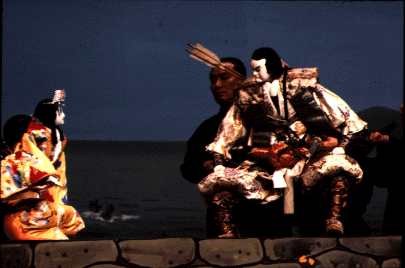Bunraku is a puppet show which was developed during the Edo era (1603-1867). Bunraku is also called "Ningyo-joruri" which literally means puppets and storytelling. There was a long tradition of travelling puppet shows and also of travelling storytelling to the accompaniment of biwa, a four- or five-stringed musical instrument similar to a lute. The two arts was joined together and Ningyo joruri was created. Although the earliest forms of bunraku was founded in the Muromachi era (1338-1573), it was the Edo era when it became popular in the Kyoto and Osaka areas. The name "Bunraku" comes from the name of the theater in Osaka, the National Bunraku Theater which is now only place to play Ningyo-joruri in Japan.
Bunraku is performed to the accompaniment of musical ballads called "gidayu joruri," and the joruri performers consists of the ballad-reciting chanter called "Tayuu" and the shamisen accompanist called "shamisen hiki." One puppet was operated by three people, each operator is responsible for different parts of the puppet. Bunraku puppets are 1-1.5 meters in height and 10 kg in weight, and the operation requires high skills.
The greatest playwriter was Chikamatsu Monzaemon, who wrote such masterpieces as Kokusenya Kassen (Battles of Coxinga)and Sonezaki Shinju (Love Suicides at Sonezaki). He created many masterpieces for both the puppet and kabuki theaters in the mid-18th century, and they have been loved and performed for years.
Go to Traditional Japanese Culture Page
Go to HOME

